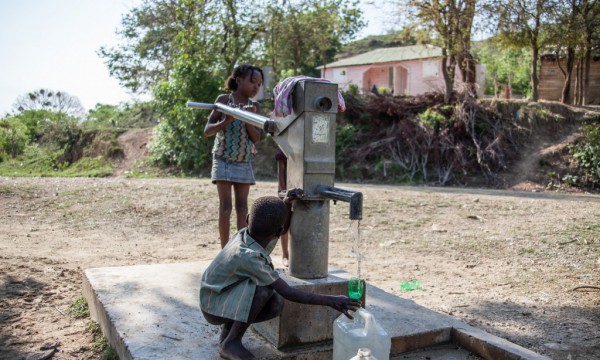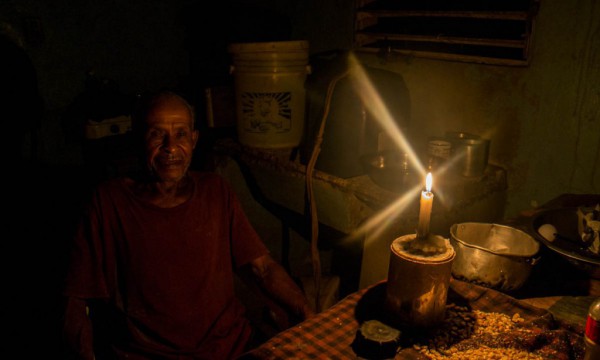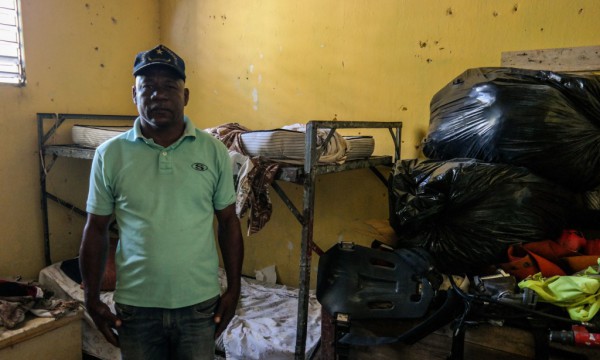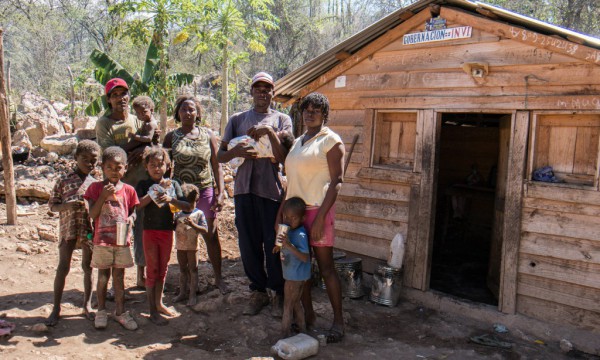The towns that live in impoverishment
In the frontier provinces there are communities without electricity or water service, and the public offices are in shabby locales and fire departments are without fire trucks
SD. When she was born, her father gave her the name of Dichosa (Lucky), because the baby was at risk of dying from respiratory complications. But the life of the little girl, one year old, as not been like her name. She doesn't walk because of a lack of vitamins; she spends the day on the floor, without clothes. On a Wednesday morning, she and another six children-her brothers and sisters and cousins-all play in front of her house. Their faces, feet and hands are full of dirt, which is more like a white dust which emphasizes their dark skins.
Milagros Medrano, Dichosa's father, is a Dominican farmer who married a woman of Haitian parentage who was born in Avila, a rural community in the frontier province of Pedernales. They have five children and none of them are in school. The seven share a small house with another Haitian family with five members. Of the four adults, only one knows how to read and write.
Medrano was able to get the provincial Governor to donate the wood for his house, with a dirt floor. In one room they have two worn down tables and an old television set. In another there are two beds: in one seven people sleep and in the other five. The clothing is stored in a bag that the women will wash in the river.
Outside, his wife is hunkered down, washing pots and pans under and an enramada. It is midmorning and she has the stove lit, boiling green bananas and macaroni. "I used to live really poorly," says Medrano.
Like them, other families in Pedernales managed to get along in a situation of impoverishment. Pedernales is one of the 32 provinces of the Dominican Republic in which the Map of Poverty which is prepared by the Ministry of Economy specifies that it has been steadily evolving towards higher levels of necessity. In 1993 it occupied position 17, and 2002 it climbed to position nine and in 2010 it was considered the second poorest province.
The poorest province is also on the frontier: Elias Piña, which has remained in the same position during the three years that were cited above. This province also has the poorest municipalities of the country: Juan Santiago, Pedro Santana and El Llano. In the population census of 2010, 41.7% of the homes had a television set, and 1.7% had access to the Internet. There is also a frontier province located in fourth place: Independencia.
So, three of the five frontier provinces are among the four poorest provinces at the national level. Dajabon, in position 14, and Montecristi at 12 have better living conditions, but with pockets of impoverishment.
These provinces occupy 17% of the country's territory, and they had 320,767 inhabitants in 2010. They are in regions that have an extensive unemployment rate of between 7.99% and 21.02%, which is the cause of the young people emigrating as soon as they reach 20 years of age.
The poverty also has as a consequence child prostitution, which although since 2012 has been made less visible by the work of the networks of agencies who work in favor of the children, can still be found in small hotels and bus and truck terminals.
"This happens all along the frontier because it is a way of life," says Adela Matos, the representative in Jimani of the World Vision NGO. She estimates that 90% of the child sex workers are Haitian, and among their clients are truck drivers and military personnel.
Given the social economic needs, besides World Vision, at least 58 entities among nongovernmental organizations (NGOs) and associations, work with vulnerable groups on the frontier.
Without water or electricity

Service of drinking water begins to get scarce where Pedernales begins, in Los Cocos, all the way to Montecristi. In some towns they get water at public faucets or wells, and in others they store it in tanks when it is supplied.
One of those communities that has problems is the housing project at Boca de Cochon, in Independencia, which, with 560 houses is emblematic of the administration of Danilo Medina. In addition, in the town of Restauracion, in Dajabon province there are still women who wash their clothes in the river.
Regarding electricity service, Pedernales, Elias Piña, Montecristi and Dajabon are among the eight provinces with the greatest lack of service. In Mencia, Aguas Negras and La Altagracia, which are farming communities of Pedernales, they have not had electricity since Joaquin Balaguer left government at the beginning of the 90s. The residents of Mencia tell how they received solar panels from the next government which was that of the Dominican Liberation Party, but some of them were sold and others were stolen.
In Aguas Negras, school is taught with the light which comes through the doors and windows. On cloudy days reading is difficult.
Representatives of the communities work with the Rural and Suburban Electrification Unit (UERS) in the construction of a mini hydroelectric project on the Mulito River. "Where there is no electricity, you can't get ahead," says Dionisio Rosario, of the Neighborhood Board of Mencia.
The goal is to take electricity service to the homes, although in Mencia there are barely 90 families because many have left due to the poor condition of the housing.
The neighbors attributed the fact that the roofs have fallen on more than 33 houses built in the decade of the 1970s, during the 12 years of Balaguer, to the deficiencies of the government engineers. Others live in units are at risk of collapsing. Pantaleon Diaz abandoned his house and went to live in a rented place. "They told me: If you stay there, one day we're going to find you completely flattened," he recalls.
At the provincial capital of Pedernales there are still buildings standing which were built by the Alcoa Exploration Company, which left the country in the middle of the 1980s. The governments of Balaguer and of the PLD also built housing projects. Nonetheless, the province has an 8.2% lack of housing, different from Elias Piña and Dajabon which are among the group with the least necessity at 2.3% and 2% respectively.

State services
Although there are schools that need remodeling and expansion, the government is investing in the frontier schools, and there are even several that are in the program of the Extended School Day.
Where an imbalance exists is in the locales of the public institutions, which because of a lack of jobs in the provinces, serve as a source of employment. Comendador, the provincial capital of Elias Piña, has a building prepared for judicial work, inaugurated in 2006. Nevertheless the Justice of the Peace of the Municipal District of Oviedo, in Pedernales occupies a house whose bathroom is also used for the storage of the archives, and water for washing is bought from tank trucks. There are only hearings on Tuesdays, when the representative of the Justice Department comes to town.
The same thing occurs with the station houses for the National Police. While they have built new stations designed in concrete, in the municipality of Juan Santiago, in Elias Piña, the station house is a dilapidated wooden house, and in the inside there is a holding cell with a wooden door; the bathroom is a latrine and the officer of the day writes out the complaints in a school notebook.
Firemen without fire trucks

The Fire Departments are not well represented. The truck at the station in Jimani, a municipality with a dry climate in the province of Independencia, has been out of service with problems in its motor for four years, and in its place the personnel use a pump to draw water for fires.
Although the station at Comendador has a truck, their hoses need replacing; also they have to repair two ambulances, and equip their members with new uniforms. In all of the town there is a single fire hydrant, placed their during the Trujillo dictatorship, which the firefighters guard jealously.


 Diario Libre
Diario Libre
 Diario Libre
Diario Libre